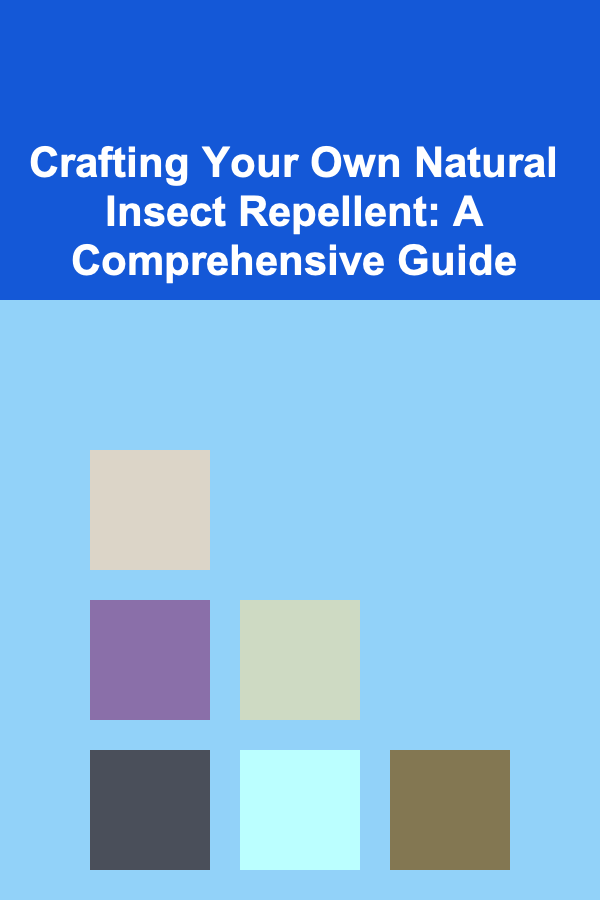
Crafting Your Own Natural Insect Repellent: A Comprehensive Guide
ebook include PDF & Audio bundle (Micro Guide)
$12.99$10.99
Limited Time Offer! Order within the next:

In a world increasingly concerned with the impact of synthetic chemicals on our health and the environment, the desire for natural alternatives has surged. Insect repellents are no exception. Commercially available insect repellents often contain DEET, picaridin, or other synthetic compounds, which, while effective, can raise concerns about potential side effects and environmental impact. This has led many to explore the world of natural insect repellents -- formulations crafted from plant-derived ingredients that offer a gentler, yet potent, defense against bothersome and potentially disease-carrying insects.
This comprehensive guide delves into the art and science of creating your own effective and safe natural insect repellent. We will explore the science behind the effectiveness of different essential oils and other natural ingredients, provide practical recipes tailored to various needs, and discuss safety precautions to ensure a positive and protective experience. This is not just about mixing a few ingredients together; it's about understanding the principles of natural pest control and empowering yourself to create a repellent that is perfectly suited for you and your family.
Understanding the Science Behind Natural Insect Repellents
The efficacy of natural insect repellents stems from the inherent properties of certain plants and their essential oils. These properties often involve disrupting the insect's olfactory system, effectively masking the scent of their human targets, or acting as direct irritants. Let's explore some key concepts:
Essential Oils and Their Active Compounds
Essential oils are concentrated hydrophobic liquids containing volatile chemical compounds extracted from plants. These compounds are responsible for the plant's characteristic aroma and often possess potent biological activity. When it comes to insect repellency, the following essential oils stand out:
- Citronella: Perhaps the most well-known natural insect repellent, citronella oil is extracted from various species of Cymbopogon grass. Its effectiveness is attributed to compounds like citronellal, citronellol, and geraniol. These compounds interfere with the insect's ability to locate hosts, effectively masking human scents. However, citronella is volatile and evaporates quickly, requiring frequent reapplication.
- Lemon Eucalyptus: Derived from the lemon eucalyptus tree (Corymbia citriodora), this oil contains a high concentration of PMD (para-menthane-3,8-diol), a compound recognized by the EPA as a registered biopesticide. PMD is considered one of the most effective naturally occurring insect repellents, often compared favorably to low concentrations of DEET.
- Lavender: Beyond its calming aroma, lavender oil contains compounds like linalool and linalyl acetate, which have shown insect repellent properties. Lavender is particularly effective against mosquitoes and moths. Its gentler nature also makes it a good choice for children and individuals with sensitive skin.
- Peppermint: The strong, invigorating scent of peppermint oil, derived from the peppermint plant (Mentha piperita), is highly repellent to many insects, including mosquitoes, flies, and ants. The active compound, menthol, disrupts the insect's sensory receptors.
- Tea Tree (Melaleuca): Known for its antiseptic and anti-inflammatory properties, tea tree oil also possesses insect repellent qualities. Its complex composition, including terpinene-4-ol, contributes to its ability to deter insects.
- Cedarwood: Cedarwood oil, particularly from red cedar (Juniperus virginiana), contains cedrol and other compounds that act as insect repellents. It's often used to repel moths and other wood-boring insects.
- Geranium: Geranium oil, especially rose geranium, contains citronellol, a compound similar to that found in citronella. It provides a floral and pleasant alternative for those who dislike the scent of citronella.
Other Natural Ingredients and Their Roles
While essential oils form the backbone of most natural insect repellents, other ingredients play crucial roles in enhancing their effectiveness, stability, and skin-friendliness:
- Carrier Oils: Essential oils are highly concentrated and should never be applied directly to the skin. Carrier oils dilute the essential oils, making them safe for topical application. Common carrier oils include:
- Coconut Oil: A moisturizing and readily absorbed oil with a mild, pleasant scent. Fractionated coconut oil (liquid at room temperature) is often preferred.
- Almond Oil: A light and non-greasy oil rich in vitamin E, suitable for most skin types.
- Jojoba Oil: Technically a liquid wax, jojoba oil closely resembles human sebum, making it readily absorbed and beneficial for skin health.
- Avocado Oil: A rich and emollient oil, best suited for dry skin.
- Olive Oil: A readily available and moisturizing oil, but can be slightly greasy.
- Witch Hazel: A natural astringent with anti-inflammatory properties. It can help to soothe irritated skin and act as a solvent for essential oils in a spray formulation.
- Vinegar (Apple Cider Vinegar): The acidity of vinegar can help to deter insects. It can be used in small amounts in spray formulations, but its strong odor may be a drawback for some.
- Aloe Vera Gel: A soothing and hydrating gel that can help to counteract any potential skin irritation from essential oils.
- Herbs and Spices (Infused Oils): Infusing carrier oils with herbs like rosemary, lemon balm, or cloves can further enhance their repellent properties. This involves steeping the herbs in the oil for several weeks to extract their beneficial compounds.
How Insects Detect Us and How Repellents Work
Understanding how insects find us is key to understanding how repellents work. Mosquitoes, for example, are attracted to a combination of factors:
- Carbon Dioxide: We exhale carbon dioxide, which mosquitoes can detect from a considerable distance.
- Body Odor: Our skin emits a complex cocktail of chemicals, including lactic acid, ammonia, and fatty acids, which vary from person to person and attract different types of insects.
- Body Heat: Insects are attracted to warm-blooded creatures.
- Moisture: Sweat and humidity can also attract insects.
Natural insect repellents primarily work by masking or disrupting these signals. Essential oils interfere with the insect's olfactory receptors, making it difficult for them to detect the host's scent. Some oils also contain compounds that are irritating to insects, causing them to avoid the treated area. The effectiveness of a repellent depends on several factors, including the concentration of active ingredients, the type of insect, environmental conditions (temperature, humidity, wind), and individual body chemistry.
Recipes for Homemade Natural Insect Repellents
Now that we understand the science behind natural insect repellents, let's explore some practical recipes that you can easily make at home. Remember to adjust the essential oil concentrations based on your skin sensitivity and the severity of the insect problem. Always perform a patch test on a small area of skin before applying the repellent liberally.
Basic Essential Oil Spray
This is a versatile and easy-to-make repellent that can be customized with your preferred essential oils.
Ingredients:
- 2 ounces distilled water
- 1 ounce witch hazel or vodka (acts as an emulsifier and preservative)
- 30-50 drops of essential oils (choose from citronella, lemon eucalyptus, lavender, peppermint, tea tree, geranium)
Instructions:
- Combine the distilled water and witch hazel (or vodka) in a clean spray bottle.
- Add the essential oils, one drop at a time, shaking gently after each addition.
- Close the bottle tightly and shake vigorously to ensure the oils are well dispersed.
- Test spray a small area of skin to check for sensitivity.
- Spray liberally onto exposed skin, avoiding the eyes and mouth.
- Reapply every 2-3 hours, or more frequently if sweating or swimming.
Variations:
- Citronella Blend: 20 drops citronella, 10 drops lemon eucalyptus, 10 drops lavender.
- Minty Fresh: 20 drops peppermint, 10 drops lavender, 10 drops tea tree.
- Floral Defense: 20 drops geranium, 15 drops lavender, 5 drops cedarwood.
Essential Oil Lotion/Balm
For those who prefer a lotion or balm over a spray, this recipe provides a longer-lasting and moisturizing repellent.
Ingredients:
- 2 ounces carrier oil (coconut oil, almond oil, jojoba oil, or a combination)
- 1/2 ounce beeswax (for balm consistency, adjust for desired thickness)
- 30-50 drops of essential oils (same options as above)
- Optional: 1/4 teaspoon Vitamin E oil (as a preservative)
Instructions:
- Melt the carrier oil and beeswax together in a double boiler or heat-safe bowl over a simmering pot of water.
- Once melted, remove from heat and let cool slightly.
- Add the essential oils and Vitamin E oil (if using).
- Stir well to combine.
- Pour the mixture into a clean container (jar or tin).
- Let cool completely before using.
- Apply a thin layer to exposed skin.
- Reapply as needed.
Variations:
- For a lighter lotion, reduce the beeswax amount.
- Add a tablespoon of shea butter for extra moisturizing benefits.
- Infuse the carrier oil with herbs like rosemary or lemon balm before melting for added potency.
Apple Cider Vinegar Spray
This simple spray utilizes the repellent properties of apple cider vinegar, combined with essential oils for added effectiveness.
Ingredients:
- 1/2 cup apple cider vinegar
- 1/2 cup distilled water
- 20-30 drops of essential oils (citronella, lavender, peppermint, eucalyptus)
Instructions:
- Combine the apple cider vinegar and distilled water in a spray bottle.
- Add the essential oils and shake well to combine.
- Spray onto clothing and exposed skin. Avoid spraying directly on the face.
- Reapply every few hours.
Note: The scent of apple cider vinegar can be strong, so use sparingly. This recipe is best for outdoor activities where the scent is less noticeable.
Herbal Infused Oil Repellent
This recipe involves infusing a carrier oil with herbs known for their insect repellent properties, creating a potent and aromatic base for your repellent.
Ingredients:
- 1 cup carrier oil (olive oil, almond oil, or jojoba oil)
- 1/2 cup dried herbs (rosemary, lemon balm, lavender, cloves)
- 20-30 drops of essential oils (optional, to boost effectiveness)
Instructions:
- Place the dried herbs in a clean glass jar.
- Pour the carrier oil over the herbs, ensuring they are completely submerged.
- Seal the jar tightly and place it in a warm, sunny location for 4-6 weeks, shaking occasionally. Alternatively, you can gently heat the oil and herbs in a double boiler for a few hours.
- After the infusion period, strain the oil through a cheesecloth or fine-mesh sieve to remove the herbs.
- Add essential oils (optional) for added potency and scent.
- Store the infused oil in a clean, dark glass bottle.
- Apply directly to the skin as needed.
Bug-Repelling Body Powder
This dry application is great for absorbing moisture and deterring insects, especially in warm weather.
Ingredients:
- 1/2 cup arrowroot powder or cornstarch
- 1/4 cup kaolin clay (optional, for extra absorption)
- 20-30 drops of essential oils (lavender, cedarwood, peppermint, tea tree)
Instructions:
- Combine the arrowroot powder (or cornstarch) and kaolin clay (if using) in a bowl.
- Add the essential oils, one drop at a time, mixing thoroughly.
- Store the powder in a sealed container.
- Apply a light dusting to exposed skin, especially in areas prone to sweating.
Safety Precautions and Considerations
While natural insect repellents are generally safer than their synthetic counterparts, it's crucial to take certain precautions to ensure a safe and effective experience:
Essential Oil Safety
- Dilution is Key: Always dilute essential oils in a carrier oil before applying them to the skin. A general guideline is a 1-3% dilution for adults (1-3 drops of essential oil per teaspoon of carrier oil). For children and individuals with sensitive skin, use a lower dilution (0.5-1%).
- Patch Test: Before applying any new essential oil blend to a large area of skin, perform a patch test on a small area, such as the inner arm. Wait 24-48 hours to check for any allergic reaction or irritation.
- Avoid Eyes and Mucous Membranes: Essential oils can be irritating to the eyes and mucous membranes. Avoid applying them to these areas. If contact occurs, rinse immediately with plenty of water.
- Photosensitivity: Some essential oils, such as citrus oils (bergamot, lemon, lime), can increase the skin's sensitivity to sunlight, leading to sunburn. Avoid using these oils before sun exposure or use them in very low concentrations.
- Pregnancy and Breastfeeding: Certain essential oils are not recommended for use during pregnancy or breastfeeding. Consult with a qualified aromatherapist or healthcare professional before using essential oils if you are pregnant or breastfeeding.
- Children: Children are more sensitive to essential oils than adults. Use lower dilutions and avoid certain oils altogether, such as peppermint and eucalyptus, in infants and young children. Lavender and chamomile are generally considered safe for children when properly diluted.
- Pet Safety: Many essential oils are toxic to pets. Keep essential oils out of reach of pets and avoid using them on or around pets without consulting with a veterinarian.
- Quality Matters: Choose high-quality, pure essential oils from reputable sources. Look for oils that are GC/MS tested to ensure their purity and potency.
Other Considerations
- Reapplication: Natural insect repellents tend to be less long-lasting than synthetic repellents and require more frequent reapplication, typically every 2-3 hours, or more often if sweating or swimming.
- Effectiveness Varies: The effectiveness of natural insect repellents can vary depending on the type of insect, environmental conditions, and individual body chemistry. What works well for one person may not work as well for another. Experiment with different recipes and essential oil blends to find what works best for you.
- Hygiene: Store your homemade repellents in clean, airtight containers in a cool, dark place to prolong their shelf life.
- Allergies: Be aware of any allergies you or your family members may have to specific plants or ingredients before using them in your repellent.
Beyond Repellents: Creating an Insect-Free Environment
While insect repellents are essential for personal protection, creating an insect-free environment around your home and yard can significantly reduce the need for repellents. Here are some tips:
- Eliminate Standing Water: Mosquitoes breed in standing water. Empty and clean out any containers that collect water, such as flower pots, bird baths, gutters, and wading pools.
- Maintain Your Yard: Keep your lawn mowed, and trim bushes and trees to reduce hiding places for insects.
- Install Screens: Install screens on windows and doors to prevent insects from entering your home.
- Use Mosquito Netting: Use mosquito netting over beds or outdoor seating areas, especially in areas with high mosquito populations.
- Attract Natural Predators: Encourage natural predators of insects, such as birds, bats, and dragonflies, by providing them with habitat and food sources.
- Plant Insect-Repelling Plants: Plant insect-repelling plants around your home and yard, such as citronella grass, lavender, rosemary, and marigolds.
Conclusion: Embracing Natural Pest Control
Crafting your own natural insect repellent is a rewarding and empowering experience. By understanding the science behind natural ingredients, experimenting with different recipes, and taking necessary safety precautions, you can create a repellent that is both effective and safe for you, your family, and the environment. Remember that natural pest control is a holistic approach, and combining the use of natural repellents with environmental management practices will provide the most comprehensive protection against bothersome and potentially harmful insects. Embrace the power of nature and enjoy the outdoors with confidence!
Disclaimer: This information is for educational purposes only and should not be considered medical advice. Always consult with a qualified healthcare professional before using essential oils, especially if you have any underlying health conditions, are pregnant or breastfeeding, or are using them on children. Perform a patch test before using any new essential oil blend on a large area of skin. The effectiveness of natural insect repellents can vary depending on individual factors and environmental conditions.

10 Creative DIY Gift Ideas That Will Impress Your Loved Ones
Read More
How to Choose the Best Saving for Retirement Strategies Based on Your Goals
Read More
How to Host a Family Talent Show at Home
Read More
How To Use Magnets for Therapeutic Purposes
Read More
How to Utilize Keyboard Shortcuts for Faster Navigation
Read More
How To Batch Tasks for Efficiency
Read MoreOther Products

10 Creative DIY Gift Ideas That Will Impress Your Loved Ones
Read More
How to Choose the Best Saving for Retirement Strategies Based on Your Goals
Read More
How to Host a Family Talent Show at Home
Read More
How To Use Magnets for Therapeutic Purposes
Read More
How to Utilize Keyboard Shortcuts for Faster Navigation
Read More